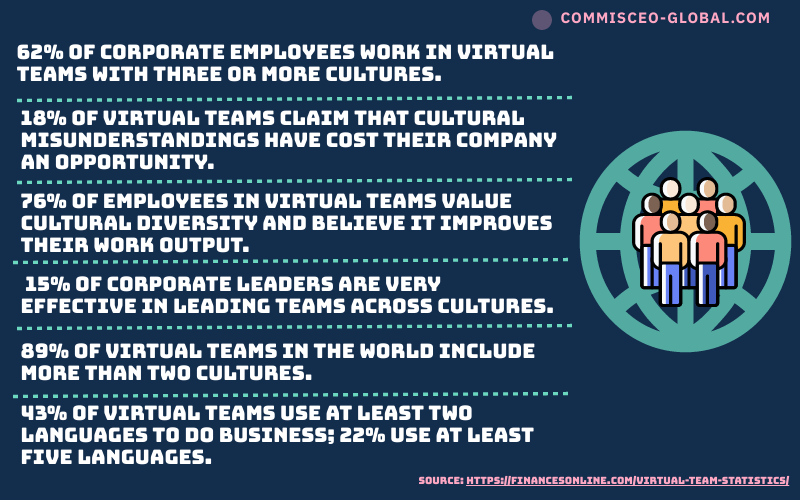4 Cultural Reasons Why Global Virtual Teams Fail
Global virtual teams are nothing new.
However, they are predicted to become increasingly common due to the COVID-19 pandemic.
More employees are working from home (WFH) and employers are realising they no longer require everyone to be in the same office.
The shift to a virtual workplace presents many challenges for people working in teams, but what challenges are presented when that team works all over the world?
In this article, we are going to explore 4 of the most common reasons global virtual teams fail.
What can managers and team members alike do to improve collaboration and perform successfully as a team?
Don't miss out!
Free SAMPLE of our eLearning COURSE on Cultural Awareness
It's at the end of the page.
Global Virtual Teams and the Impact of Cultural Diversity
Research shows that organizations understand the impact of culture.
However, it also suggests that
- not enough is being done to address issues,
- meet challenges and
- forge new ways of working that help teams achieve their goals.
Let’s look at some of the headline statistics.

These stats clearly illustrate that
- global virtual teams are important,
- that they need taking care and
- if left to their own devices, things can go wrong.
4 Important Reasons Why Global Virtual Teams Go Wrong
1. Poor Clarity Over Goals & Direction
Right from the get-go, those working in virtual teams should be well aware of the group goals, the direction and what the priorities are.
It is very common for those working in global virtual teams to get fed up with working within the structure as they feel constantly lost.
Where teams have an ‘HQ’ or central office that makes decisions, changes decisions a lot or simply has poor internal communications, this is especially true. Those working in teams elsewhere either don’t get the news or get it too late. This leads to all sorts of problems.
It’s crucial that virtual teams always know what they should be doing, why, how and when.
2. Confusion Around Roles & Responsibilities
Within global virtual teams, this is perhaps one of the most impactful reasons for failure as some cultures can differ dramatically in terms of expectations around jobs, tasks and accountability.
Some cultures prefer a hands-on management style, whereas others prefer to be left to it. When the two mix without an understanding of this dynamic difference it can lead to severe challenges around task completion, accuracy and deadlines.
Team members need to be explicitly guided on what their roles entail and what responsibilities they carry for the team.
Individuals should also always be aware of how they fit into the larger team and who they report to, turn to for help, etc. The same is then true of virtual teams being shown how they fit into the global picture.

Conflict is normal in any team, let alone culturally diverse, global teams.
Find out how to prevent conflict in virtual teams here.
Photo by Christina Morillo from Pexels
3. Lack of Trust, Communication & Cooperation
Everyone who has worked virtually knows and understands the impact of not being physically present with team members has on the areas of trust and communication.
It’s not the same, and it’s for this reason that this is usually an area worked on in team coaching or training.
People need to know each other, understand one another, appreciate the other’s view and learn to adapt to differences around communication and ‘getting things done’.
When a global virtual team is just ‘left to it’, what usually happens is people form into groups and sub-groups, stifling the flow of critical information and business intelligence.
4. Insufficient Contact & Poor Engagement
One could argue that this reason alone creates the conditions for all the other reasons mentioned above to take place.
Many professionals working in global virtual teams point to a lack of real engagement as resulting in not feeling challenged, having ineffective colleagues, dealing with conflict and lacking direction.
If there is no meaningful contact within the wider organization, satellite teams can be left feeling unloved, disconnected and marginalized. This does nothing positive for anyone.
It’s critical that virtual teams have not only lots of contact but that it is varied, purposeful, useful and nurturing of the wider organizational values and goals.
Training for Global Virtual Teams
We hope you enjoyed our article!
If you would like guidance on working virtually in global teams, we offer training designed specifically for teams and organisations facing similar challenges to those mentioned above.
Take a Course on Working Across Cultures. Only $15!
Although it’s not specifically about virtual teamwork, our Cultural Awareness eLearning course is a valuable resource if you want to learn some of the fundamentals of working with people from different cultures.
You can watch a sample of the course below, or go to the course page to learn more about the contents.
Related Posts
By accepting you will be accessing a service provided by a third-party external to https://www.commisceo-global.com./

 +44 0330 027 0207 or +1 (818) 532-6908
+44 0330 027 0207 or +1 (818) 532-6908

